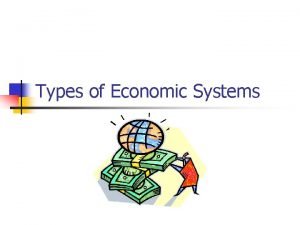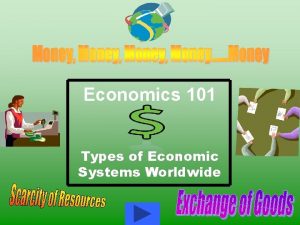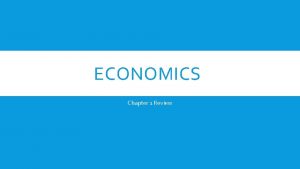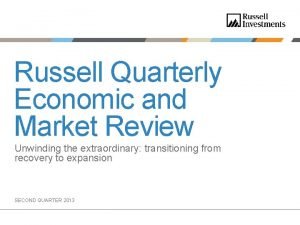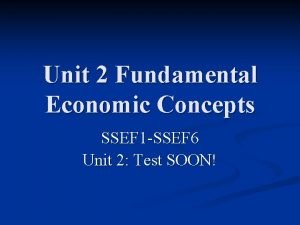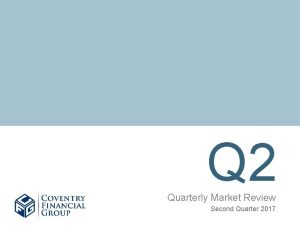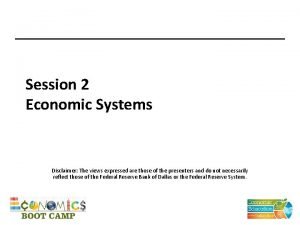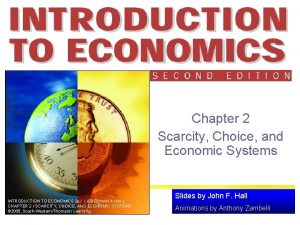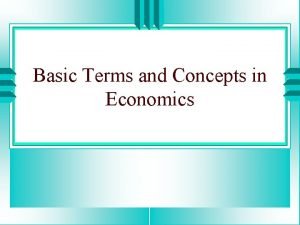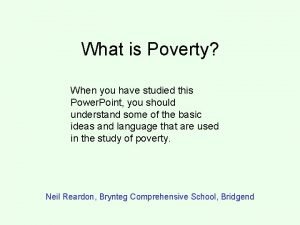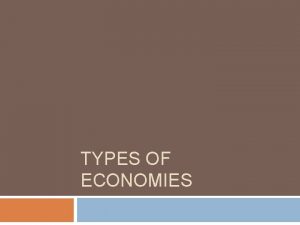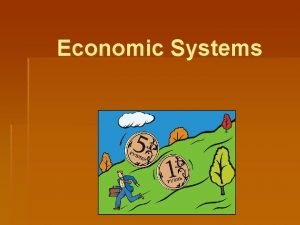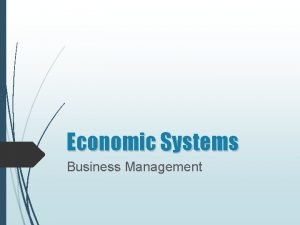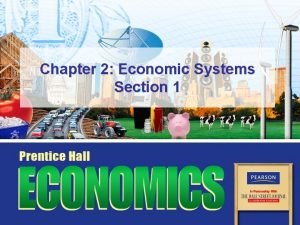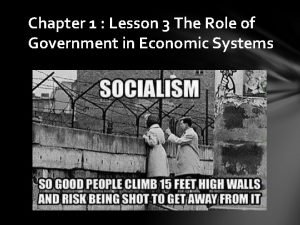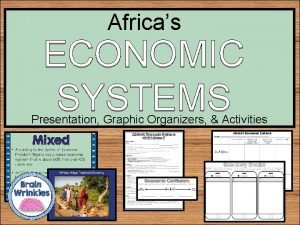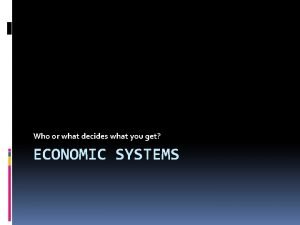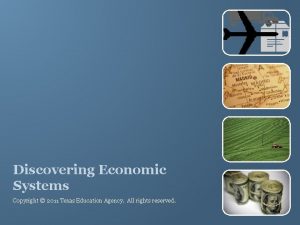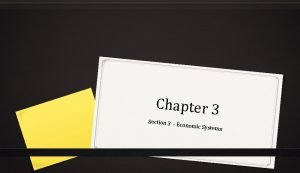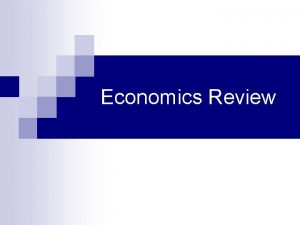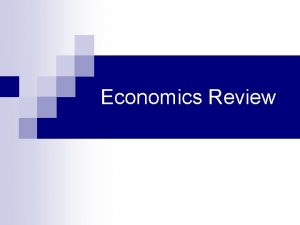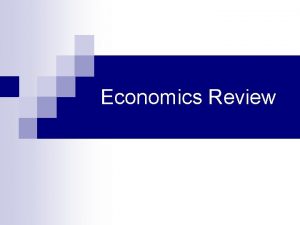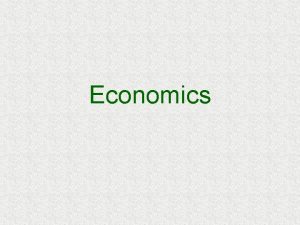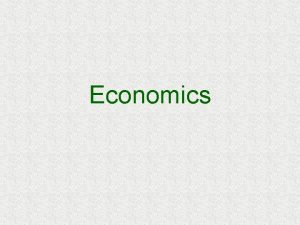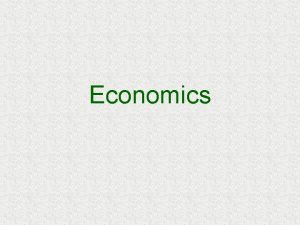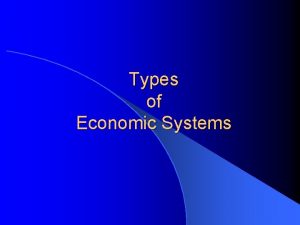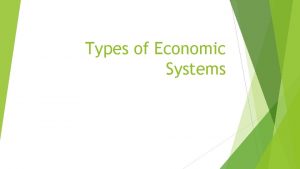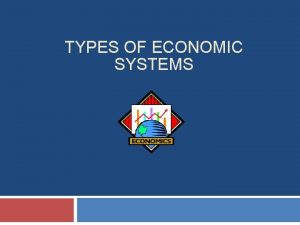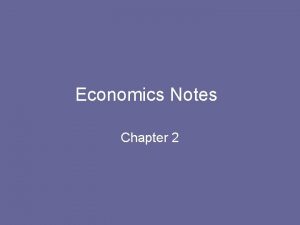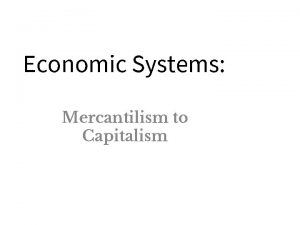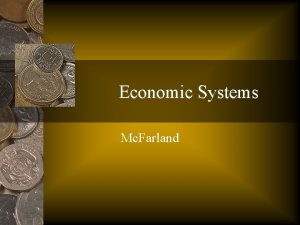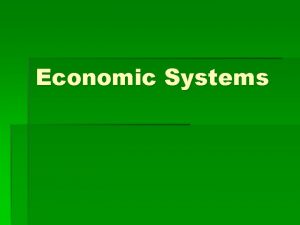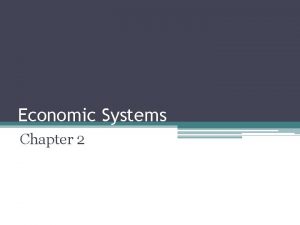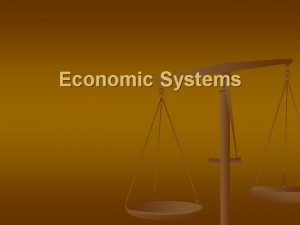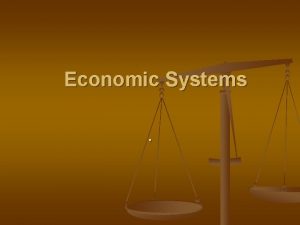Economics Review Economic Systems Types of Economic Systems








































- Slides: 40

Economics Review

Economic Systems

Types of Economic Systems n Traditional – people produce & distribute goods according to custom ¨ Tribes n Command – the government makes all economic decisions ¨ China, n in Africa North Korea Market – individual choice & voluntary exchange direct decisions ¨ U. S.

What is a “Market”? n where buyers and sellers interact to trade goods and services ¨ (it can be actual store like Acme (a “supermarket”) or an online market like Amazon or even the New York Stock Exchange (a “stock market”) the market (the buying and selling) of a product like cars or cheeseburgers can be impacted by changes in the supply and demand n

Supply and Demand

Economic definitions for DEMAND n Demand: the total amount consumers are willing and able to buy at all prices.

n Demand curve: the graphical representation of what consumers are willing and able to buy.


n Law of Demand: As price increases/decreases, quantity demanded decreases/increases. P Q

Factors that cause demand to change or shift n Tastes and fads n Income n Number of buyers n Future price expectations n Price and availability of: ¨Substitutes ¨compliments

n Inelastic Demand: Price still moves up and down but Demand stays the same


Economic definition for SUPPLY n Supply: the total amount of a good or service producers are able to make at all prices.

n Supply curve: the graphical representation of a good or service producers are able to make at all prices.


n Law of Supply: as price increases/decreases, quantity supplied increases/decreases P Q

Factors that cause a change in supply: n Price of land, labor or capital n Technology n Number of other sellers n Price of other goods I could produce n Tax policy

n Equilibrium Point: the point at which the quantity demanded & the quantity supplied are equal


Surplus & Shortage n Surplus – Quantity supplied is greater then quantity demanded n Supplied 10 ice cream cones but could only sell 4 You have a surplus of 6 cones! n

Surplus & Shortage n Shortage – Quantity demanded is greater then quantity supplied n Supplied 4 ice cream cones but you had 10 customers You were short 6 cones! n

IRDL When Supply & Demand shift: n Increase in Supply/Demand = shift Right n Decrease in Supply/Demand = shift Left n Increase Right Decrease Left

Shift in Supply Lines

Shifts in Demand Lines

Let’s Try It! n Discuss with your neighbor the impact of the following headline on the market for Orange Juice? Surprising Drop in Temperatures Brings Early Frost to Florida

Discuss n What changed? (supply of Orange Juice or Demand for Orange Juice) n Did it Increase or Decrease? n What will happen to the price of Orange Juice?

Supply 2 P Supply 2 Demand

Business Cycle

Business Cycle n Series of expanding and contracting economic activity. n Stages: ¨ Expansion ¨ Peak ¨ Contraction ¨ Trough

Business Cycle Stages n Expansion – increase in the GDP; jobs increase, higher demand & prices n Peak – where GDP reaches its highest point

Business Cycle Stages n Contraction– GDP declines; producers cut back, resources become less scarce, prices stabilize, & unemployment rises ¨ Recession – a contraction that lasts for six months or more ¨ Depression – extended period of high unemployment & lower business activity n Trough – point when GDP & employment stop declining


Interdependence Due to a division of labor, a reliance on one another to produce all the goods and services needed A Farmer… …may grow vegetables but relies on someone else to make overalls and build trucks and tractors A Factory Owner …. . may assemble trucks and tractors but relies on someone else to make the tires and spark plugs not to mention the food for his family and workers to eat!

Economic Indicators n a statistic about an economic activity. n allow analysis of economic performance and predictions of future performance. n Economic indicators help us study BUSINESS CYCLES Examples: unemployment rate, housing starts, stock market prices and Gross Domestic Product

n Gross Domestic Product – all the goods & services produced by a nation w/in a certain time GDP


Another indicator of the strength of the economy is the Stock Market

n n n Stocks are ownership in a company Stocks are divided into shares All the shares make up all the ownership in the company If you had a company divided into 100 shares and you owned fifty shares, you would own half the voting rights (decision making power) in that company A share entitles you to a percentage of the profit earned by the company Your are paid “dividends” on a regular basis

The profit making ability of a company helps to determine how much a stock costs The more stocks that are traded and the more money spent – the more people are investing in business

 Economic systems lesson 2 our economic choices
Economic systems lesson 2 our economic choices Economics and business economics maastricht
Economics and business economics maastricht Elements of mathematical economics
Elements of mathematical economics Command economy
Command economy Command economy
Command economy Fundamental economic concepts in managerial economics
Fundamental economic concepts in managerial economics Economics chapter 1 review
Economics chapter 1 review Unit 1 review economics
Unit 1 review economics Economic growth vs economic development
Economic growth vs economic development Difference between economic growth and economic development
Difference between economic growth and economic development Elena motoiu
Elena motoiu Russell quarterly economic and market review
Russell quarterly economic and market review Ssef price list
Ssef price list Russell quarterly economic and market review
Russell quarterly economic and market review Chapter review motion part a vocabulary review answer key
Chapter review motion part a vocabulary review answer key Ap gov review final exam review
Ap gov review final exam review Nader amin-salehi
Nader amin-salehi Prisma diagram example
Prisma diagram example Narrative review vs systematic review
Narrative review vs systematic review Economics systems
Economics systems Economics systems
Economics systems Types of poverty in economics
Types of poverty in economics Types of utility in economics
Types of utility in economics Types of poverty
Types of poverty Three types of economy
Three types of economy Demand estimation techniques
Demand estimation techniques Being resourceful meaning
Being resourceful meaning What economic system is germany
What economic system is germany Pure command system
Pure command system How many economic systems are there
How many economic systems are there Chapter 2 economic systems and decision making answer key
Chapter 2 economic systems and decision making answer key Command economy political cartoon
Command economy political cartoon Chapter 2 economic systems answer key
Chapter 2 economic systems answer key Chapter 2 economic systems and decision making
Chapter 2 economic systems and decision making Comparing economic systems worksheet
Comparing economic systems worksheet Lesson 3 the role of government in economic systems
Lesson 3 the role of government in economic systems Africa's economic systems cloze notes 1
Africa's economic systems cloze notes 1 Who or what decides what you get?
Who or what decides what you get? Free enterprise and other economic systems
Free enterprise and other economic systems Discovering economic systems comparative worksheet answers
Discovering economic systems comparative worksheet answers The three economic systems
The three economic systems



